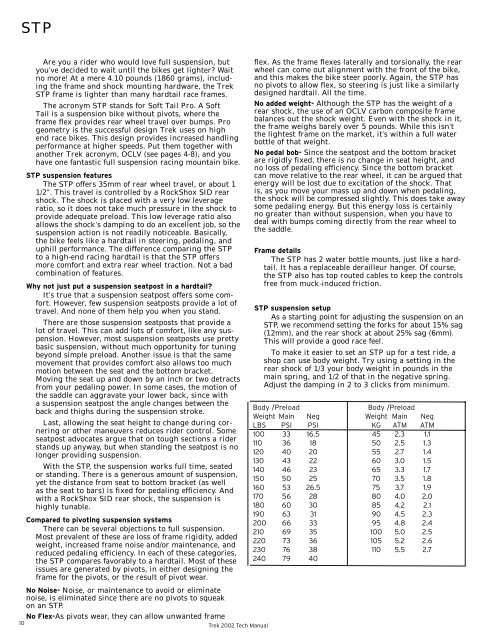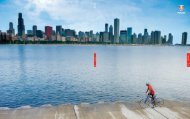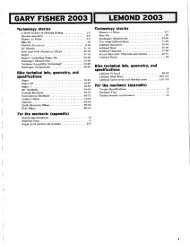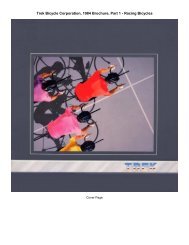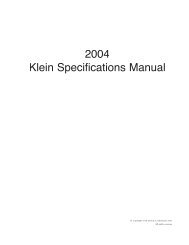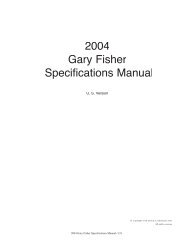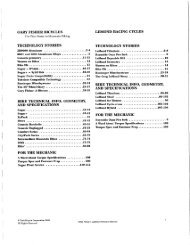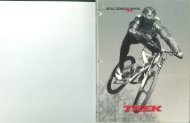TECHNOLOGY STORIES BIKE INFO, GEOMETRY ... - Vintage Trek
TECHNOLOGY STORIES BIKE INFO, GEOMETRY ... - Vintage Trek
TECHNOLOGY STORIES BIKE INFO, GEOMETRY ... - Vintage Trek
You also want an ePaper? Increase the reach of your titles
YUMPU automatically turns print PDFs into web optimized ePapers that Google loves.
STP<br />
Are you a rider who would love full suspension, but<br />
you’ve decided to wait until the bikes get lighter? Wait<br />
no more! At a mere 4.10 pounds (1860 grams), including<br />
the frame and shock mounting hardware, the <strong>Trek</strong><br />
STP frame is lighter than many hardtail race frames.<br />
The acronym STP stands for Soft Tail Pro. A Soft<br />
Tail is a suspension bike without pivots, where the<br />
frame flex provides rear wheel travel over bumps. Pro<br />
geometry is the successful design <strong>Trek</strong> uses on high<br />
end race bikes. This design provides increased handling<br />
performance at higher speeds. Put them together with<br />
another <strong>Trek</strong> acronym, OCLV (see pages 4-8), and you<br />
have one fantastic full suspension racing mountain bike.<br />
STP suspension features<br />
The STP offers 35mm of rear wheel travel, or about 1<br />
1/2”. This travel is controlled by a RockShox SID rear<br />
shock. The shock is placed with a very low leverage<br />
ratio, so it does not take much pressure in the shock to<br />
provide adequate preload. This low leverage ratio also<br />
allows the shock’s damping to do an excellent job, so the<br />
suspension action is not readily noticeable. Basically,<br />
the bike feels like a hardtail in steering, pedaling, and<br />
uphill performance. The difference comparing the STP<br />
to a high-end racing hardtail is that the STP offers<br />
more comfort and extra rear wheel traction. Not a bad<br />
combination of features.<br />
Why not just put a suspension seatpost in a hardtail?<br />
It’s true that a suspension seatpost offers some comfort.<br />
However, few suspension seatposts provide a lot of<br />
travel. And none of them help you when you stand.<br />
There are those suspension seatposts that provide a<br />
lot of travel. This can add lots of comfort, like any suspension.<br />
However, most suspension seatposts use pretty<br />
basic suspension, without much opportunity for tuning<br />
beyond simple preload. Another issue is that the same<br />
movement that provides comfort also allows too much<br />
motion between the seat and the bottom bracket.<br />
Moving the seat up and down by an inch or two detracts<br />
from your pedaling power. In some cases, the motion of<br />
the saddle can aggravate your lower back, since with<br />
a suspension seatpost the angle changes between the<br />
back and thighs during the suspension stroke.<br />
Last, allowing the seat height to change during cornering<br />
or other maneuvers reduces rider control. Some<br />
seatpost advocates argue that on tough sections a rider<br />
stands up anyway, but when standing the seatpost is no<br />
longer providing suspension.<br />
With the STP, the suspension works full time, seated<br />
or standing. There is a generous amount of suspension,<br />
yet the distance from seat to bottom bracket (as well<br />
as the seat to bars) is fixed for pedaling efficiency. And<br />
with a RockShox SID rear shock, the suspension is<br />
highly tunable.<br />
Compared to pivoting suspension systems<br />
There can be several objections to full suspension.<br />
Most prevalent of these are loss of frame rigidity, added<br />
weight, increased frame noise and/or maintenance, and<br />
reduced pedaling efficiency. In each of these categories,<br />
the STP compares favorably to a hardtail. Most of these<br />
issues are generated by pivots, in either designing the<br />
frame for the pivots, or the result of pivot wear.<br />
No Noise- Noise, or maintenance to avoid or eliminate<br />
noise, is eliminated since there are no pivots to squeak<br />
on an STP.<br />
No Flex-As pivots wear, they can allow unwanted frame<br />
10<br />
<strong>Trek</strong> 2002 Tech Manual<br />
flex. As the frame flexes laterally and torsionally, the rear<br />
wheel can come out alignment with the front of the bike,<br />
and this makes the bike steer poorly. Again, the STP has<br />
no pivots to allow flex, so steering is just like a similarly<br />
designed hardtail. All the time.<br />
No added weight- Although the STP has the weight of a<br />
rear shock, the use of an OCLV carbon composite frame<br />
balances out the shock weight. Even with the shock in it,<br />
the frame weighs barely over 5 pounds. While this isn’t<br />
the lightest frame on the market, it’s within a full water<br />
bottle of that weight.<br />
No pedal bob- Since the seatpost and the bottom bracket<br />
are rigidly fixed, there is no change in seat height, and<br />
no loss of pedaling efficiency. Since the bottom bracket<br />
can move relative to the rear wheel, it can be argued that<br />
energy will be lost due to excitation of the shock. That<br />
is, as you move your mass up and down when pedaling,<br />
the shock will be compressed slightly. This does take away<br />
some pedaling energy. But this energy loss is certainly<br />
no greater than without suspension, when you have to<br />
deal with bumps coming directly from the rear wheel to<br />
the saddle.<br />
Frame details<br />
The STP has 2 water bottle mounts, just like a hardtail.<br />
It has a replaceable derailleur hanger. Of course,<br />
the STP also has top routed cables to keep the controls<br />
free from muck-induced friction.<br />
STP suspension setup<br />
As a starting point for adjusting the suspension on an<br />
STP, we recommend setting the forks for about 15% sag<br />
(12mm), and the rear shock at about 25% sag (6mm).<br />
This will provide a good race feel.<br />
To make it easier to set an STP up for a test ride, a<br />
shop can use body weight. Try using a setting in the<br />
rear shock of 1/3 your body weight in pounds in the<br />
main spring, and 1/2 of that in the negative spring.<br />
Adjust the damping in 2 to 3 clicks from minimum.<br />
Body /Preload Body /Preload<br />
Weight Main Neg Weight Main Neg<br />
LBS PSI PSI KG ATM ATM<br />
100 33 16.5 45 2.3 1.1<br />
110 36 18 50 2.5 1.3<br />
120 40 20 55 2.7 1.4<br />
130 43 22 60 3.0 1.5<br />
140 46 23 65 3.3 1.7<br />
150 50 25 70 3.5 1.8<br />
160 53 26.5 75 3.7 1.9<br />
170 56 28 80 4.0 2.0<br />
180 60 30 85 4.2 2.1<br />
190 63 31 90 4.5 2.3<br />
200 66 33 95 4.8 2.4<br />
210 69 35 100 5.0 2.5<br />
220 73 36 105 5.2 2.6<br />
230 76 38 110 5.5 2.7<br />
240 79 40


